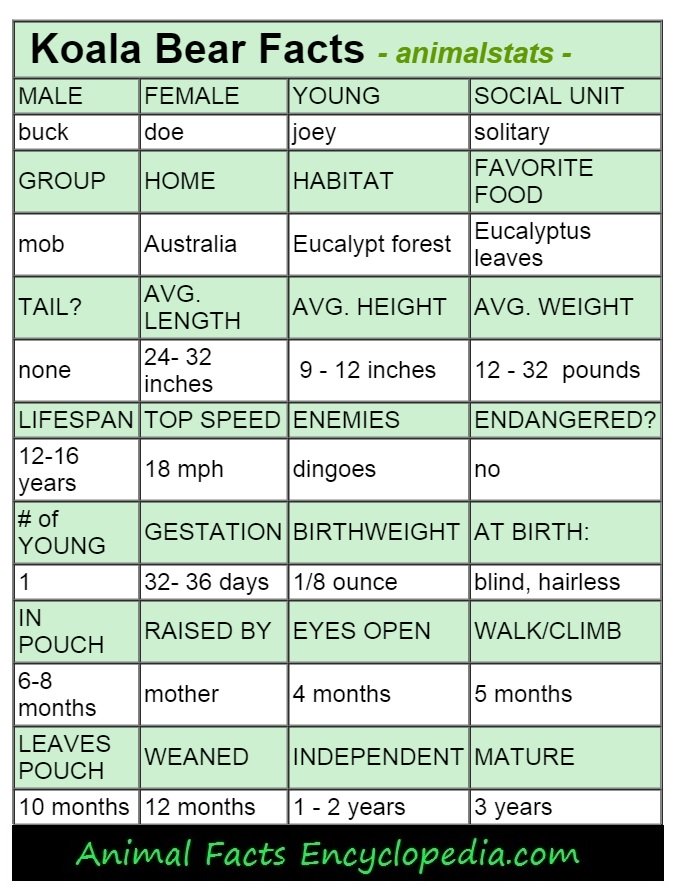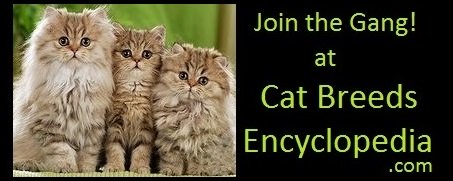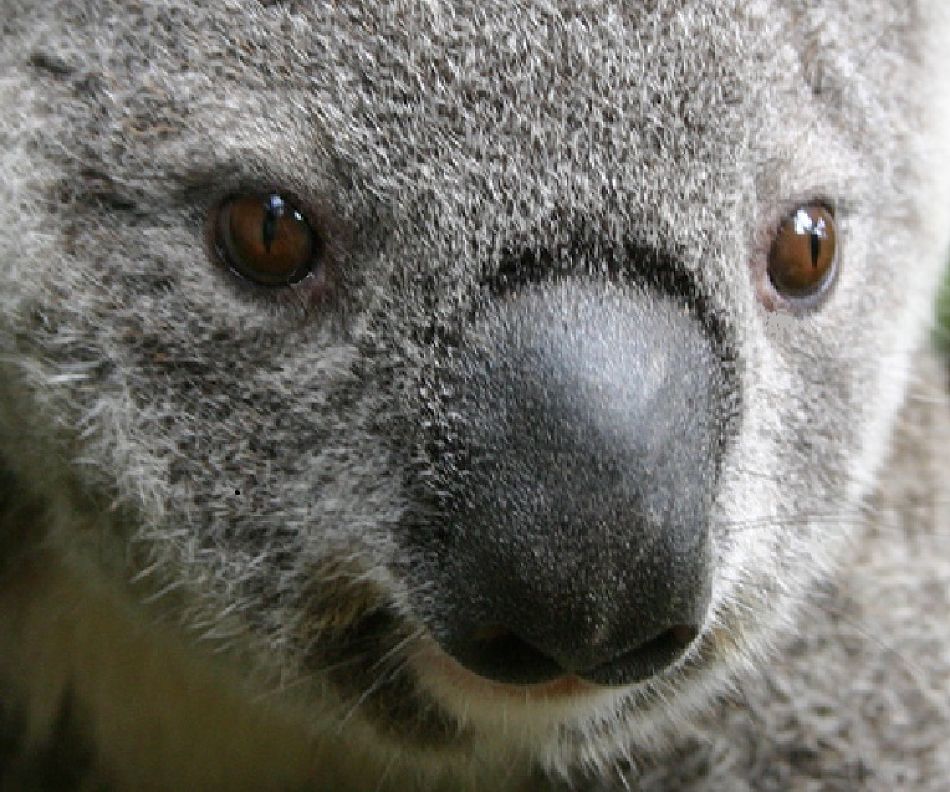koala bear Facts
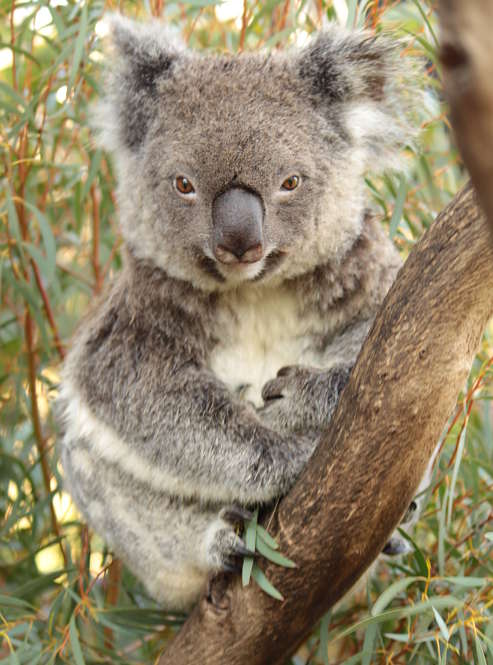 Portrait of a Koala Bear
Portrait of a Koala BearThe koala bear is an adorable, tree dwelling marsupial that is perhaps the most popular animal native to Australia. Koalas live in Eucalypt forests, spending the vast majority of their lives in just a handful of eucalyptus trees, also known as gum trees.
These animals are nocturnal and spend four to six hours a night quietly munching on Eucalyptus leaves.
In the course of a single evening, a 30 pound koala consumes about 2 pounds of leaves.
The nutritional value of this diet is so poor that the koala is designed to conserve as much energy as possible. A healthy adult koala spends about 18 hours a day sleeping - mostly in the heat of the afternoon - and no more than 5 minutes a day in full-bodied exertion.
Moving from one to another of the trees that it has designated as its territory is the most energy a koala will commit in any 24 hour period.
Very much like the South American sloths in lifestyle, the koala bear has an extremely slow metabolism and takes days to digest a meal.
The koala bear has a broad face with forward facing eyes, a large head with round tufted ears and an egg-shaped tailless body covered with plush grey to brown fur that is whiter on the undersides and often mottled over the rump.
They are not social at all, marking out clear territories, and actively avoiding each other throughout most of their lives, other than for very brief mating encounters.
Naturally, the koala has a darling expression, but its big head contains one of the smaller brains percentage wise in the animal kingdom, and a rather primitive one at that.
With its only natural enemy, the dingo, delegated to the ground, the koala is basically safe from threat. Birds of prey or snakes may take an occasional youngster or small female, but this is rare.
The biggest issue koalas face is their own territorial and anti-social nature. There is a finite number of koalas that can comfortably coexist in a particular area of wild habitat, and when territory is depleted by human encroachment, the individuals whose trees are lost usually perish.
Fortunately, the fabulous koala is not endangered and can still be viewed in the wild.
koala bear claws and colonies
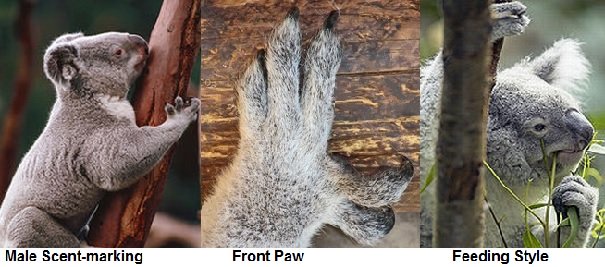

Koalas spend more than 90% of their lives high up in the trees. They are deliberate climbers and do not swing from branch to branch like some monkey or rodent species.
Koala bears have special claws that make grasping and climbing easy. The front paws have five digits like a little hand. The two digits that might be considered the thumb and index finger are semi-opposed to the other three digits.
These dexterous little claws make climbing easier, for sure, but also help in feeding, as the koala usually pulls branches to its mouth with a front paw to slowly eat the leaves off.
The koalas hind legs have somewhat of a locking mechanism built in, with the thigh and shin bones attached in a way that makes it very comfortable for the koala to maintain the pose in which it is so often seen, latched vertically, directly to the side of a branch.
The end of the spine has a thick pad made of cartilage that makes the arrangement even more comfortable. Koalas live in colonies of several individuals, each of which has its own territory made up of specific trees that it has marked with scratches and urine scent.
Males also have special scent glands directly in the center of their chest that secrete a sticky fluid. The male koala actively rubs his chest against the trunks and branches of his "home trees" leaving his specific scent, so other koalas will be wary.
Koalas are not social animals at all, and basically avoid or ignore the other members of the colony, except during breeding season. They do have overlapping territories, where some trees may be shared, and occasionally koalas may meet in a shared tree, but there is very limited, if any, interaction.
They may be a branch away from one another and never look at or otherwise acknowledge each other, like strangers on a subway train.
The koalas in a colony are all aware of each other from the calls they make and the marks they leave on trees, but it is possible for individual to live in the same colony for 15 years and never interact or even meet.
This is most likely motivated by the lack of time available to the koala.
With its poor food source, the koala spends so much time on getting energy by eating 4 to 6 hours a day, and preserving energy by sleeping the other 18 to 20, that it just doesn't have time for an active social life.

do koalas eat poop?
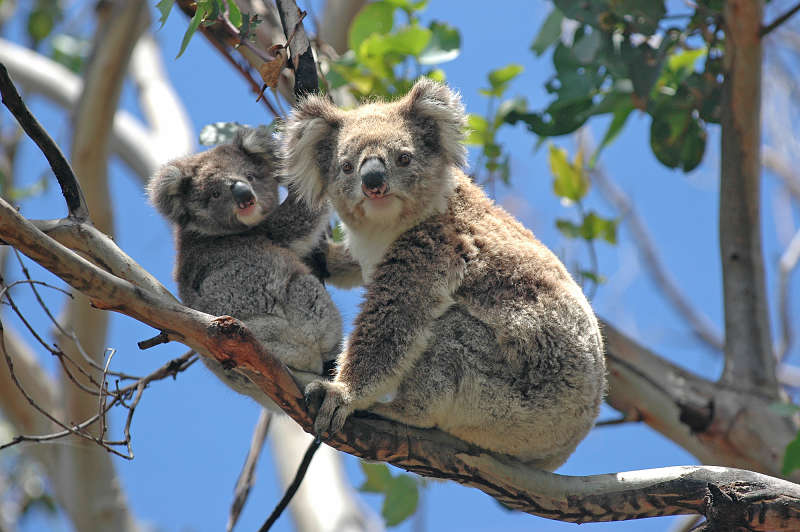
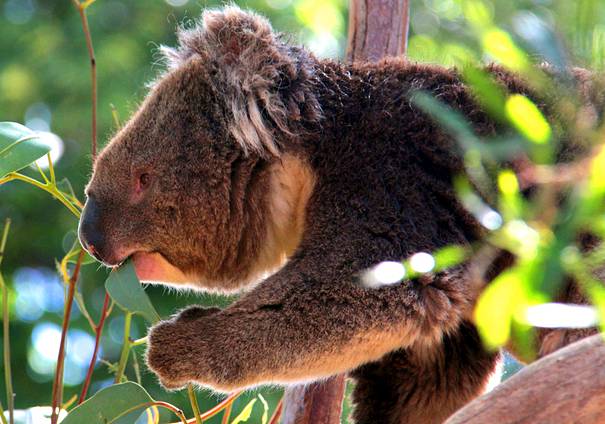
In order for the young koala to eat an adult diet of eucalyptus leaves, which are actually toxic to most mammals, its mother must pass on special micro-organisms from her intestine, which will allow the baby to properly digest.
The mother begins to produce a substance called "pap" which is actually a specialized type of feces completely unique to koalas. Pap is a completely different substance from the dry, pelleted feces that koalas usually produce (and which the mother continues to produce as a normal course of digestion). It is sticky and liquidy and beleived to come from a seperate part of the intestines called the caecum.
From the safety of the pouch, the joey leans out and feeds on the pap as it is excreted by the mother. Joeys consume pap, along with mothers milk, as a vital part of their diet for about 2 months.
They are then able to begin safely trying out some tasty leaves without fear of toxins. Although copopragia, or the eating of feces, is common in many animals, particularly herbivores, and is actually essential for some young animals to do in order to obtain healthy bacterias, the specialized feces produced by the koala is completely unique to the koala.
When it is strong enough, the baby rides on its mothers back and the will stay with its mother for a full year until a new joey emerges from the pouch. If the mother has not been impregnated that year, the baby may stay for an additional year, greatly increasing its chances of survival.
Once it heads off on its own, the young koala must find an area that has not been claimed by another koala. It may be lucky enough to inherit the trees of a koala that has recently passed, or it may have to journey to find unclaimed trees.
This is an extremely stressful and dangerous time for the young koala, and they often succumb to injuries obtained as they are chased from one claim to another.
The territorial nature of koalas is why the preservation of their habitat is so vital. There is a very limited number of animals that can safely populate any given territory. This is ratio is known as the "carrying capacity" and when habitat is removed, and the carrying capacity exceeded, the overcrowded koalas do not adapt well.
Instead of living safely in their home trees, sleeping or dining on leaves, they must take to the ground to find new trees that are not already claimed by another koala.
While traveling like this they are vulnerable to attacks by dingoes, domestic dogs and automobiles, as well as the extreme stress of losing their home. Many koalas die of starvation or simple exhaustion in this situation.
chillin in the trees
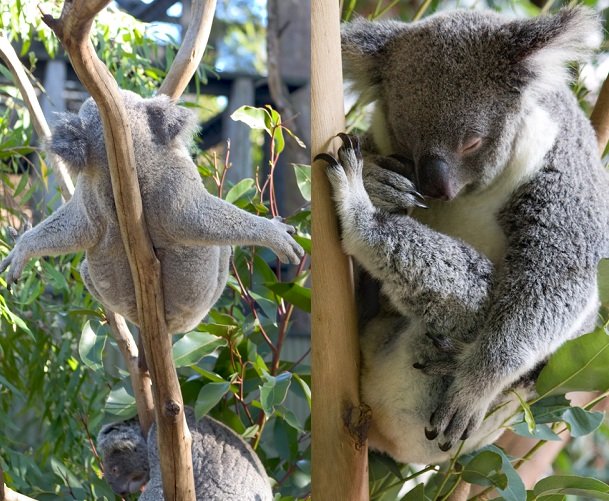 koalas napping
koalas nappingKoalas spend 18 to 20 hours a day sleeping, but that doesn't mean it has to be a boring 20 hours.
Koala bears may sleep in any number of exotic positions, usually hooking safely into the crook of a branch, but sometimes dangling precariously.
The art of the nap does not get lost on the masterful koala. Koalas usually sleep quite high in branches and the mottled fur on their posterior makes for good camaflauge from below.
Their habit of melding with branches and their limited activity level - they have about 1/2 the metabolism rate of most other mammals - makes it very difficult for researchers responsible for recording data on koala populations, to keep track of them.
A secret weapon in the koalas quest for comfort is a dual purpose coat. The fur on its back is very dense and almost water resistant, it is an excellent insulator, especially when the koala balls up against the elements.
The belly fur, however, is less than 1/4 the density of the fur on the rest of the body. Although koalas have no sweat glands, the thin fur on the underside allows them to release allot of heat through their bellies, so it is not uncommon to see them sleeping with thier bellies completely exposed in the heat of the day.- Koala Bear Facts
a few more koala facts
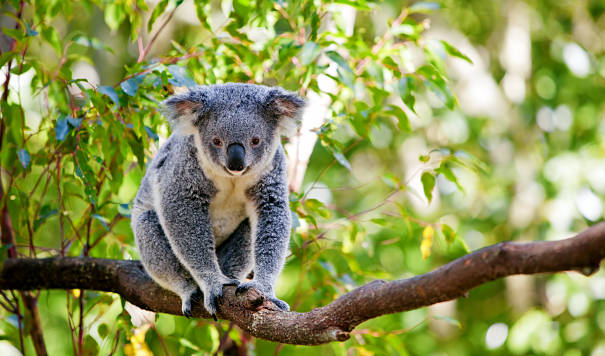
- The koala is not a bear and is not related to any bear species
- The word "koala" is an Aboriginal term for "no drink" because the koala gets most of its hydration from the leaves it eats
- Koalas sleep between 18 and 20 hours a day
- Koalas smell like eucalyptus cough drops
- Male koalas have a scent gland on their chest that they rub on their home trees to mark them
- The mothers pouch is called a "marsupium", and is where the word "marsupial" comes from.
- A male koala is called a buck, a female koala is called a doe and a baby koala is a joey
- Nearly 4,000 koalas are killed each year by domestic dogs and automobiles, but the real culprit is deforestation which sends them to the ground to search for new habitat - Koala Bear Facts
| Koala Bear Facts - animalstats - | |||
|---|---|---|---|
| MALE | FEMALE | YOUNG | SOCIAL UNIT |
| buck | doe | joey | solitary |
| GROUP | HOME | HABITAT | FAVORITE FOOD |
| mob | Australia | Eucalypt forest | Eucalyptus leaves |
| TAIL? | AVG. LENGTH | AVG. HEIGHT | AVG. WEIGHT |
| none | 24- 32 inches | 9 - 12 inches | 12 - 32 pounds |
| LIFESPAN | TOP SPEED | ENEMIES | ENDANGERED? |
| 12-16 years | 18 mph | dingoes | no |
| # of YOUNG | GESTATION | BIRTHWEIGHT | AT BIRTH: |
| 1 | 32- 36 days | 1/8 ounce | blind, hairless |
| IN POUCH | RAISED BY | EYES OPEN | WALK/CLIMB |
| 6-8 months | mother | 4 months | 5 months |
| LEAVES POUCH | WEANED | INDEPENDENT | MATURE |
| 10 months | 12 months | 1 - 2 years | 3 years |
see more animal extreme closeups
Recent Articles
-
African Animals - Animal Facts Encyclopedia
Oct 11, 16 10:27 PM
African Animals facts photos and videos..Africa is a wonderland for animal lovers, and a schoolroom for anyone who wants to learn about nature, beauty and the rhythm of life -
Baboon Facts - Animal Facts Encyclopedia
Oct 11, 16 10:26 PM
Baboon facts, photos, videos and information - Baboons are very distinctive looking monkeys with long, dog-like snouts and close set eyes. -
Great Apes Facts - Animal Facts Encyclopedia
Oct 11, 16 10:25 PM
Great apes facts, photos and videos..Human beings did not evolve from chimpanzees, modern chimps and gorillas do not appear in the fossil records until much more recently than homo sapiens..
